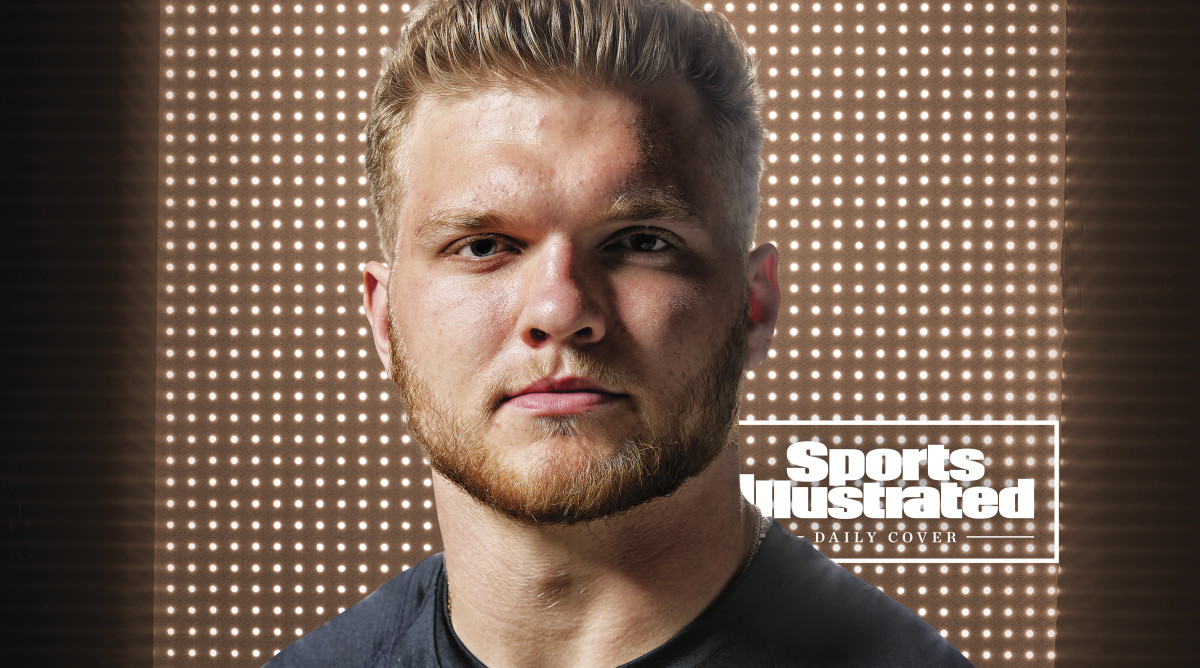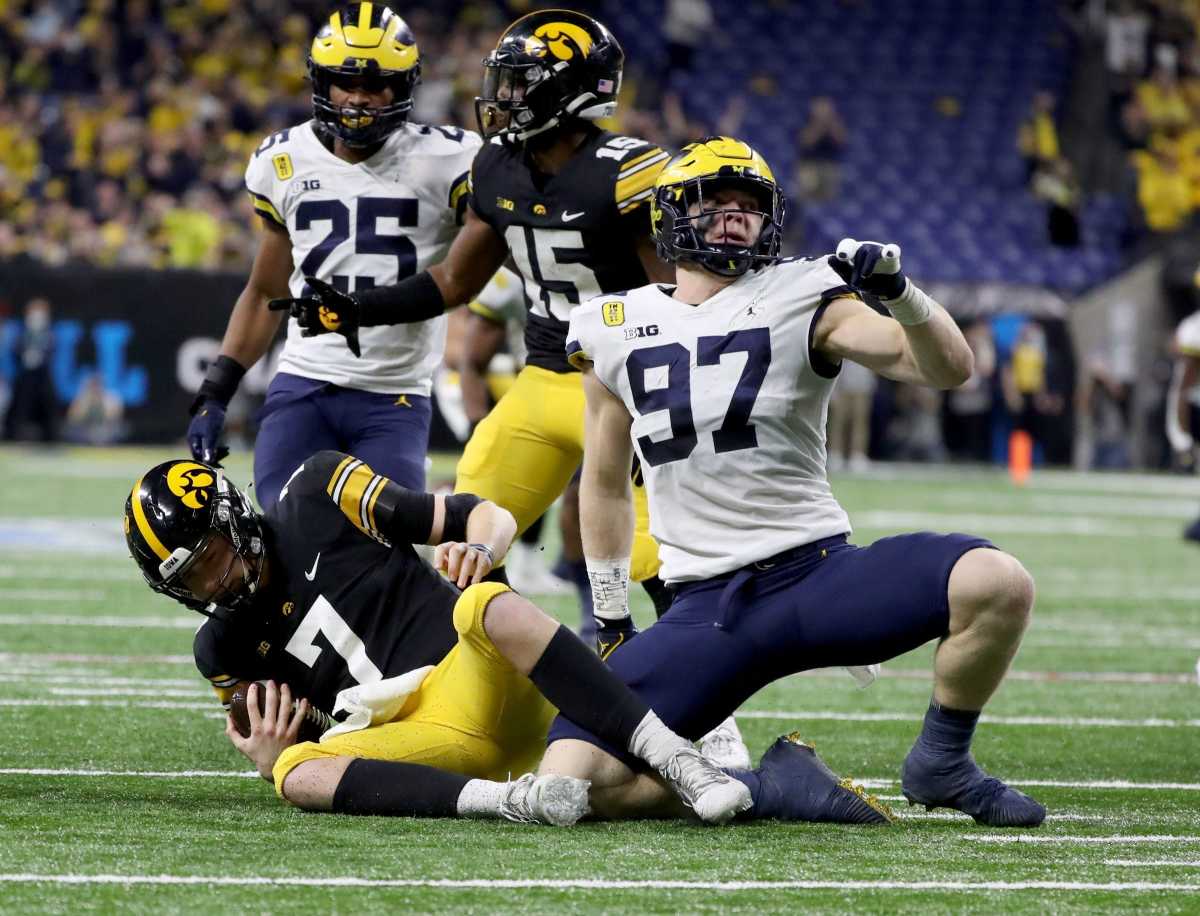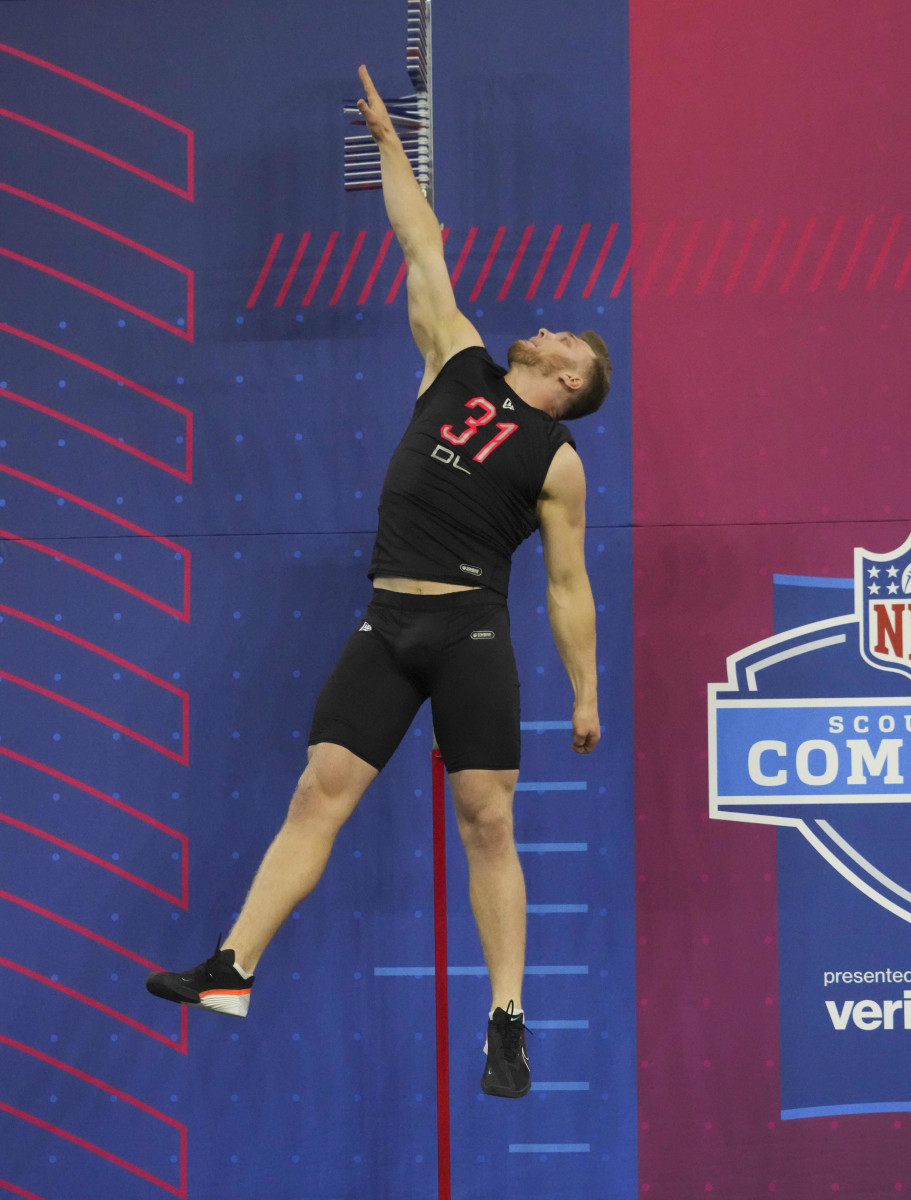2022 NFL Draft: Aidan Hutchinson’s Rise to Potential Top Pick
The man whose name may be called first at the NFL draft has a habit that perfectly fits his persona. Instead of answering a question with “yes,” Aidan Hutchinson often defaults to “100 percent.”
This is how the Michigan defensive end plays and how he lives. He is a geyser of maximum effort. He will run to the football. He will play to the whistle. He will battle blockers and hammer runners and chase quarterbacks until the last dog dies.
Inspired by Tom Brady, he will drink distilled water almost exclusively, a gallon a day. He is a clean-living fanatic who cut out sugar and gluten and alcohol. He is a workout warrior who elevates the exertion level of those who sweat with him. Everything is geared toward maximizing his physical potential.
“He’s projected first off the board, one of those caliber players, and he’s working as if he’s about to be drafted in the sixth round,” says Minnesota defensive end Boye Mafe, who worked out with Hutchinson leading into the NFL combine.

There is some debate about whether Hutchinson is the best player in this draft class. There is much less debate about who is the safest pick. “There’s not a lot of questions or doubts,” says one NFL executive involved in player evaluation. “You watch the tape and you know what the guy is going to be like in your building. You’re going to love having him.”
Hutchinson knows the value of putting 100-percent effort on film for the NFL. He’s long been wired that way, because he knows who else is watching. “I don’t want my dad up in the crowd to see me not sprinting to the ball,” Hutchinson says.
Chris Hutchinson knows what he sees. He was an undersized All-American defensive tackle and the Big Ten Defensive Lineman of the Year at Michigan three decades before his son followed in his footsteps. He wasn’t as big or as talented as Aidan turned out to be, going undrafted in 1993 and washing out of the NFL after a rookie stint in Browns training camp ended with an adverse reaction to a tetanus shot. Chris went to med school instead and is an emergency room doctor at Beaumont Hospital in Royal Oak, Mich. But he had lessons to pass along that stuck with Aidan and his two older sisters, starting with one nonnegotiable: 100-percent effort.
“Whatever you do, I don’t care if you’re any good,” Chris Hutchinson told his kids. “But you’re going to try hard. If you don’t try hard, that’s when I have a problem.”
When Aidan was a star at Divine Child High School in Dearborn, he and Chris had a Friday postgame routine. They’d sit on the edge of Aidan’s bed and watch the downloaded film of the game together. In one game, Aidan’s coach was utilizing him as a decoy wide receiver, splitting him out from his usual tight end spot, and Aidan was not exactly busting it off the line of scrimmage.
Chris pointed that out. Aidan responded he was just there to preoccupy the secondary while plays were run to the opposite side of the field. Chris said that didn’t matter, that if you’re on the field you go hard, and that the video sent a bad message to college recruiters.
Then Chris checked Aidan’s play count for that game: He’d logged 134 snaps, playing both ways and on almost all special teams. “Dad got a reality check,” Chris says with a laugh.
The 100-percent lesson already had been learned.
Jim Harbaugh has bestowed his highest accolade on Hutchinson: “Football player.”
When Michigan beat Nebraska 32–29 in a tense road game in October, raising its record to 6–0 and bringing Big Ten championship dreams into sharper focus, Hutchinson and Harbaugh celebrated at the final gun by screaming in each other’s faces. What the moment lacked in articulation, it made up for in sincerity and intensity.
Harbaugh’s postgame explanation of his feelings for Hutchinson: “So much respect. I respect you. You’re a real football player. Look at a Justin Smith or a Frank Gore, Hassan Haskins, Andrew Luck—the ones where you just say ‘football player.’ ”

Both Hutchinson and Harbaugh grew up in football families. Jim’s dad, Jack, was a college coach, and older brother John (now the coach of the Ravens) played as well. There was an expectation set for how the game should be played.
“They’re wired that way,” Harbaugh says of sons of a player or coach. “You’ve got to tell them not to play if they’re hurt. It’s not, ‘No, Dad, I’m not going to play. Got a pimple on my ass, not going to play this week.’
“You never want it to be where you didn’t hustle on a play, or you turned down a hit, you tried to get out of a workout. I don’t want my father or brother to think I’m a coward. You’ve got to do it right. You respect them so much that you’ve got to give it your very best, or you know they’re going to be on you.”
Beyond the imperative to play hard, Chris Hutchinson did not force-feed Aidan too much football too early. They watched a lot of games together—Aidan grew up a huge Patriots fan—but Aidan wasn’t allowed to play tackle football until seventh grade. And he wasn’t much of a physical specimen in those early years.
When Aidan showed up for preseason camp in ninth grade, he was 6' 1" and 155 pounds. By the time he graduated high school, he’d grown five inches and gained about 100 pounds. He was a four-star prospect who drew attention around the Midwest, but there was never much doubt where he would go.
Despite being the son of a star player, Aidan still had a lot to learn at Michigan. Other than effort, Chris didn’t critique much. He waited for his son to come to him to really dig into the details of defensive line play—footwork, handwork, the subtle arts of a savage game.
“I look back now at all the things I didn’t know in high school and I’m like, How do you hold back all that information?” Aidan says. “But it was pretty cool of him to do. I don’t know how our relationship would have developed if he was constantly correcting me or telling me what to do. I’m grateful for that.”
Hutchinson started to flourish as a sophomore at Michigan, recording 4 ½ sacks and 10 tackles for loss. Firmly on NFL radars, he delivered two productive performances to start his COVID-19-shortened junior season. Then he fractured an ankle in the third game, at Indiana.
Harbaugh says that after the game, Chris Hutchinson told him that Aidan would be back for his senior season; he wasn’t going out with a 2–4 half season and so many unfulfilled goals. His father won four Big Ten championships and never lost to Ohio State; Aidan had neither of those things. “I really haven’t accomplished anything,” he said last year.
Once the ankle healed and he was cleared medically to resume workouts, he went to strength coach Ben Herbert with a simple but steep request: “Every day I come in here, wring me out. Squeeze every ounce of talent out of me.”
Thus began the most intense offseason of Hutchinson’s life, and it benefited everyone. He got better, but so did workout partner and fellow defensive end David Ojabo—to the point that Ojabo’s breakout season put him in the first-round discussion (even after a torn Achilles at his pro day, Ojabo is expected to crack the top 50). Plugging those two into new defensive coordinator Mike Macdonald’s system, they combined for 25 sacks (14 by Hutchinson, 11 by Ojabo).
Hutchinson was the Heisman Trophy runner-up, the highest a Michigan player has finished in the voting since Charles Woodson won it in 1997. The team success he hungered for came as well, with an upset romp of Ohio State, a Big Ten title, a 12–2 record and the Wolverines’ first berth in the College Football Playoff. His work in maize and blue was complete. “Everything that I set out to achieve, I did,” he says.
There is just one problem with being a 100-percent guy. It comes with the perception that success is due solely to effort. It suggests a compensation for lack of physical talent. This was the context surrounding Hutchinson heading into the NFL combine—a reliable prospect but perhaps not a spectacular one.
He was considered to have a higher floor and lower ceiling than some other players. Nobody was comparing him athletically to freaks such as the Bosa brothers, Myles Garrett, Jadeveon Clowney or Von Miller.
“You’re just going to have to get comfortable with the fact that he’s talented but not crazy talented,” one NFL scout says. “When you watch Joey or Nick Bosa move, Aidan just can’t quite move like that.
“He’ll attack his weaknesses. He’s going to do exactly what you tell him. There’s not a lot of guys in this draft better than him. But you’re going to get what you get with him.”
Adds a second NFL scout: “There’s not too much risk with him. Is it worth taking him at the top? I don’t know. When you take an edge player in the top three, you’re probably hoping for a 15-sack year. With Aidan, he might be more of a 10-sack guy.
“He could be a Chris Long—people forget how good he was. He had a very good career but not a Hall of Fame career.”
Then Hutchinson went into Indianapolis in March and put up a strong athletic performance. Not every measurement was ideal—the new knock is arm length, with Hutchinson measuring a somewhat stubby 32 1/8". Some were concerned that he’s too tall after measuring 6' 7", thus lacking the ability to get leverage underneath the punch of bigger offensive tackles. And his 40-yard dash wasn’t dazzling (4.74 seconds).
But his three-cone drill and 20-yard shuttle times were the stuff of high-end skill players. What he might have lacked in straight-line speed, Hutchinson made up for in small-space quickness. That at least altered the narrative.
“People say he’s a motor guy, a hustle guy—there’s more to him than that,” Chris Hutchinson says. “They don’t understand how much of an athlete he is.”

While the athleticism debate simmers, Aidan touts another element of his game as his best attribute—intuition coupled with preparation. He is devoted to film study and will absorb a scouting report, but Aidan says he also has something of a sixth sense about what is going to happen when the ball is snapped.
“I think that’s what separates me,” he says. “I can see what’s coming before the play goes; I can just feel it. That makes you look so much better as a player. You look faster; you look quicker.”
It’s not hard to find video of Hutchinson blowing up misdirection plays that are supposed to dupe defensive ends. Waggles and bootlegs designed to influence him have ended up in sacks, turnovers or forced throws. Whether that’s a product of true intuition or diligent study of the opponent, who knows—but maybe being a second-generation defensive lineman with a dad who knows the game helps, too?
“Hundred percent,” Aidan Hutchinson says, smiling.
Read more of SI’s Daily Cover stories here:
• Why Pass Rushers Will Rule the NFL Draft
• Kayvon Thibodeaux Hears His Critics and Has a Plan
• Behind the Spectacle of Kaepernick’s Comeback Tour
